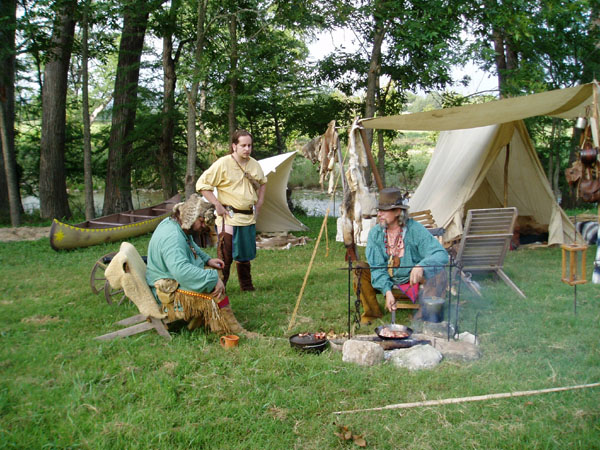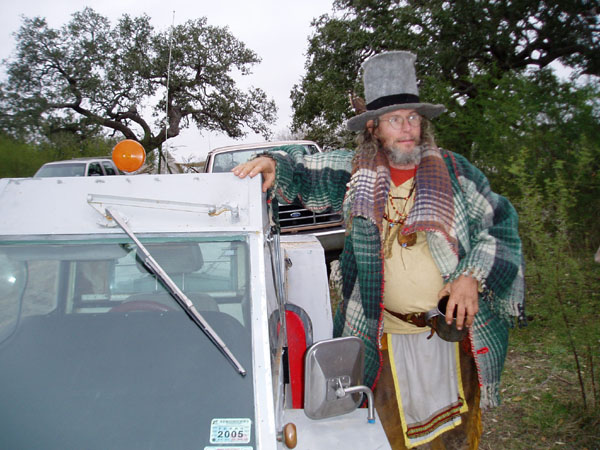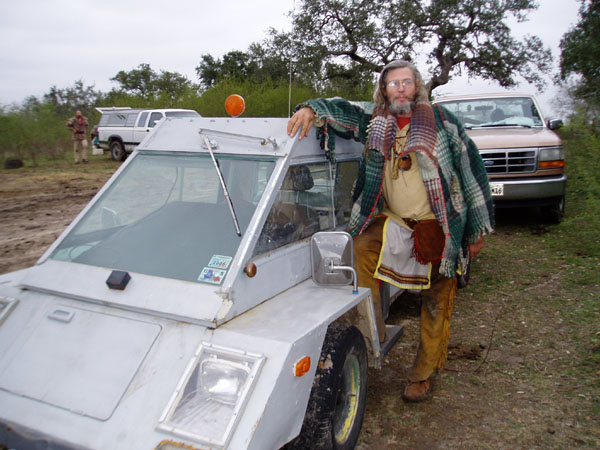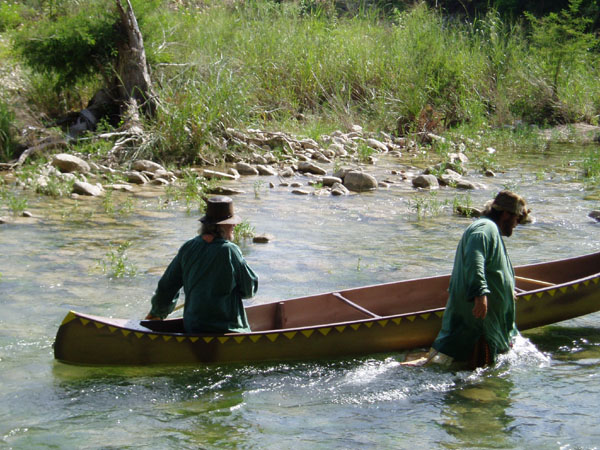Short story: 3 tents burn in one day, nobody seriously hurt. Two tents belonged to Cajun Johnny, & Bugs and Linda, and the tipi was George Wilburn’s.
Long story: (scroll down for fire details)
I have some pics of the SW, including fire-damage, up on my Photobucket website here:
http://s6.photobucket.com/albums/y208/soquili/Southwestern%202008/
click on the box at left on that page for pics of the buffalo skinning demo in another folder, or use this link:
http://s6.photobucket.com/albums/y208/soquili/Southwestern%202008/
Buffalo%20skinning%20demo%20SW%202008/
Um, if you are squeamish or the sight of blood bothers you, or you are a vegetarian, better not go to that second link!LOL It’s for carnivores only…
Other than the fire thing, we had a good time at the SW! Cuz and John went up on Thursday and ran into snow around Dennison, last 3 hours were 20 miles an hour in 4-wheel drive in a blizzardy near-white-out, pulling the ‘voo trailer. So they grabbed a motel room in Atoka for the night and drove out on Friday morning and set up then. Muddy conditions at the site due to the melted snow, but it had good grass cover so it was ok except for the road in.
I got there late Friday (had 20-mile-an-hour driving too for a while as I hit Dallas at 5:00 on a Friday – LOL) and promptly got stuck but had sense enough to shut the car off and not spin the wheels and wait till the next day to get out. It froze during the night and the road in was easier after that.
Camp was in a beautiful valley with some seeps and springs in the middle. Camp wound up being kind of strung out, as folks camped along the road going in, due to wet conditions the first weekend. Long-term was on the right end going in, traders strung out along the middle and around the camp meeting place, and rowdy camp and short-term on the left side. So ya got yer exercise wandering from one end to the other!
John Billington got hisself a fancy new pony for this one, a red 4-wheeled electric scooter, so he got to go “cruisin’ and perusin'” any time he felt like it! Said it was like being let out of jail, he didn’t realize how much he missed that freedom since he had to go on oxygen and be tied down. I tried to talk him and Iron Hand into a race with their scooters, but they wouldn’t do it! Iron Hand’s scooter had 3 wheels, so my money was on John’s hoss! John will probably bring his new red pony to the TAB, so git ready for him to come say “hello the camp” and bum a beer off ya!
Sterling and Kelly did a great job as booshways, handling all the fun things that a big ‘voo throws at ya. It’s always a challenge! For folks who complain about such things, my thought is, “here’s yer clipboard, let’s see how you would do it”. I know I appreciate all the hard work and planning that goes into an event like that, or even a regular weekend ‘voo, so my hat’s off to all of you who have stepped up and given it your best shot. Thanks!
We camped next to Lil’ Griz, and he’s always a riot to be around. 🙂 Jonathan Carlin was on the other side of us and James Bryan camped with him for a few days, good neighbors too – thanks for the wine selection, Jonathan! Slayer and Bobcat weren’t too far away, and brought us some grilled trout one day – delicious!! There was an older couple behind us who had a big gooseneck trailer with a winch and offloaded a cool log cabin for the week! Beautiful painted tipi behind us too, belonging to Russ and Marnie from Wisconsin, I think. Russ played a mean guitar, and Marnie plays harmonica, so they added to the ambiance over near Bugs and Willie Glover’s tents for music around the fire. Daing I can’t remember their names, but the two guys who play bagpipes and bodhrans were there, and Steve Sprinkle too, and Critter, and several other folks. Cyrus showed up later in the week with his Jew’s harps and string bass. CRS, can’t remember the long-haired bushy-bearded fellow who has the website with pics on it (something-Bear) but he was there too, and played at Miss Andrea and Turtle Woman’s “Blushing Ankle” saloon/tavern a couple of nights. John and Cuz and I had a good time there too, and John developed a new fondness for grapes! 🙂 Serving wenches were very talented, and so were the strapping young serving boys at the ladies’ social held there! I hear lots of quarters were won and lost at the nightly card games there too.
I took my Malamute, Shadow, and he had a fun time going “wooo-woooo” and getting folks to pet him and tell him he was purty. Crafty lil’ devil made an escape from his crate one night when I didn’t quite get the bolt latch all the way closed after a midnight pee trip, and sneaked out of the tent to do a little “tipi-creeping'” of his own at about 3am. One of the folks he surprised was No-Nose’s wife Teresa, who had stepped out of the tent to answer the call of nature, and she looked up from a squat to find herself eye-to-eye with what she thought was a wolf at first, till she saw his collar! She found out she could cut it off in mid-stream! His next visit was over to the other traders who had a full-blood female wolf (half timber, half red wolf) named Baby, who had been flirting with Shadow the day before. Turns out she only wanted to play and wasn’t in the mood, but the racket they made woke up her owner twice. So the second time he caught Shadow but didn’t know exactly where I was camped, so he took him out to the gate where there were some trailers for trash and the water buffalo, figuring that trailer’s safety chain would hold his big ass till morning. Naturally I had a heart attack when we woke up a little after sunup and Cuz said “Where’s Shadow??” and his crate was empty!! The last time he went on walkabout at my house, he was gone 4 days and I found him 5 miles as the crow flies from the house! Luckily then too, some folks had tied him up – he’ll git shot for a wolf if a rancher catches him on their place. So as I dashed out to find Shadow, some neighbors said they had seen him at the gate and saved me time in the search. Found him wet but warm, thanks to his thick waterproof fur, and glad to see me. But he did git a serious lecture about his escapades. So we came home and found out the story about his new almost-girlfriend from her owner on the way, and I thanked him profusely for containing my rascal and saving him from causing any more trouble.
John’s dog Dakota went too, and she had a fine time fetching the rubber foot squeaky toy and badgering everyone but us into playing tug-of-war with her! Shadow and Dakota get along and he got to meet lots of dogs, but I think his favorites were Jan’s little Jack-Rat terrorist named Mouse and Irish Kat’s little 6-month old Lhassa named Princess. They were gutsy little pups who made friends with the big dog pretty fast.
OK, now for the tent fire stories, compiled from eyewitnesses.
1. First one happened not far from our tent just after folks had shut down the music and gone to bed. There was a Cajun guy named Johnny from Lafayette, thick Cajun accent, good cook by all accounts, and had some good homemade hooch that was about 140 proof and would shoot a blue flame 4 feet high when he spit a mouthful into the fire, and he had a great sense of humor too – this was his first Rendezvous and I hope it won’t be his last, despite what happened. I heard all this after the fact, so correct me if I’m wrong, but apparently Cajun Johnny had one of those Coleman gas cylinders with a heater on it in his tent, and was changing out the cylinder. They say if you get them cross-threaded, it can break off a little needle thingy in the valve, and apparently that is what happened, and when he turned the heater on again, gas was spewing out and it caught his tent on fire. Cajun Johnny ran out and called for help and folks came running, but his tent was on the ground in less than 60 seconds. So they helped him pack what was left of his gear and got him on his way to a motel for the night.
2. About 30 minutes after the first fire, folks were taking care of Bugs who was a close neighbor there, because he was having a pain in his chest. Then they noticed that Bugs’ and Linda’s tent was glowing pretty red, and daing if it wasn’t on fire too, on the back side!! So folks came a-running again with fire extinguishers and water and put it out. Had some trouble doing it, flames from the gas were shooting way up above the roof. Somehow, Cuz and John and I slept through it all. With the tents being so close together over there, it is a wonder more tents did not catch from the two that burned. So what happened with Bug’s is, either when he and Linda jumped up to help Cajun Johnny, or later when their dogs were in the tent, somehow a candle or candle lantern got knocked over onto a pillow on top of the big propane tank they had in there for the heater and Coleman cookstove, and it caught the pillow on fire and burned through the hose on the propane tank. So that fire got a little propane help too, and burned up the back wall of Bugs tent. He rushed into the burning wall tent, with help from others, to rescue his dogs and his 3 guitars, which were fine. In the process he and another guy inhaled a good bit of smoke, and Bug’s chest was still hurting, so the medics gave oxygen to the other guy, and sent Bugs to the hospital to get checked out and to treat the minor burns on his hand. He was released the next day and is fine, other than a light minor burn on two fingers and a little singed beard hair. They lost a few things, some hanging clothes, but their buckskin shirt and dress and Whitney blanket survived. Lil Griz even fixed up Bug’s hat for him.
3. AS IF that weren’t enough, the next day about mid-afternoon, folks hollered “Fire” again and came a-runnin’ to the other end of camp where George Wilburn’s tipi was on fire. According to George, he was cooking a pot of beans for supper on the fire out in front of the tipi, and had just put some link sausage into the beans. He had set a pan of bread dough to rise near the fire, and was watching it as he went across the road to speak to a neighbor for a minute. Wasn’t gone but a minute, and kept looking back at his fire. The wind was blowing pretty hard from his fire toward the tipi, and next time he looked, a spark had jumped out of the pit and across the log ring and had caught the dry grass and was headed for the door of the tipi! Before he could run across the road (20 feet) and grab the pan of dishwater by the fire it had caught the canvas at the base of the door and tipis being the good chimneys that they are, it went right up the canvas and burned it to the ground. George and his wife lost a lot of gear, but no one was hurt. Good thing the wind wasn’t blowing from the other direction too, because his daughter was in the tent on the other side of the fire changing the grandbaby’s diaper and there is no back door to that tent. George was devastated, he has been Rendezvous-ing for 30 years or so, and knows fire safety and is very careful with it, but it just shows how fast things can go south on ya. He had made that tipi himself, and he and his wife had just harvested the poles and trimmed and sanded them and oiled them. Most of the poles can be re-used, but a few were too charred. The tipi canvas was a total loss.
So camp had an emergency fire safety meeting later that afternoon, bringing certified EMS medics in attendance to the front so folks could see who their medic-neighbors were and know who to call, and having the folks who had a fire extinguisher in camp to raise their hand and keep it up so folks could see who their neighbors were again and know where to turn in case of another fire. They had fire patrols out at night after that, if your fire was not out and banked with dirt, they put it out and you got a lecture. I don’t think they had to give many lectures, as folks were pretty paranoid and careful after that. Found out you need an A-B-C fire extinguisher, not a B-C one. B-C is for electrical and chemical fires, The “A” in A-B-C is for wood, paper, canvas, basically anything that will make an Ash. So the A-B-C kind is the one to get. I think I’m going to make a canvas cover for Cuz’s and put a flame symbol or the word Fire on it and keep it out by the fire instead of under the canvas by the coolers or in the tent. That way anyone who needs it can come get it, and find it easily. One real nice thing, there was a guy at the ‘voo who refills fire extinguishers for a living, and he refilled anyone’s fire extinguisher for free in the parking lot, who had used it up on fighting the fires. Great fellow, real nice thing to do.
Funny thing is, as I was driving home from the ‘voo there was someone on the radio talking about fire danger and how fast a grass fire can move. He said it can burn along at 4 miles an hour. Now that may not sound too fast, but if you do the math, that is one mile of country in 15 minutes, so…(5280 feet divided by 15 minutes is 352 feet per minute – yikes!) that means a grass fire fueled by a high wind and dry grass CAN BURN AN AREA THE LENGTH OF A FOOTBALL FIELD IN LESS THAN A MINUTE. LESS. THAN. A. MINUTE. That’s about SIX FEET PER SECOND. That is why George’s tipi burned – only took a SECOND or two for that fire to jump the 8 feet or so to the canvas, even with him carefully watching and only 20 feet away. FIRE IS OUR FRIEND BUT IT IS A DANGEROUS BEDFELLOW…
At any rate, like I said, we had a great time otherwise. Enjoyed visiting with old friends and met a lot of new folks, including a trader named Lisa from Arkansas, the “Gypsy Potter”. She has some great white-glazed pottery dishes and cups made from historical examples of the colonial era, some pretty green-glazed ware too, and she made some cool historically accurate pit-fired bowls and pipes from the Moundbuilder culture that were fine too. One Cherokee pipe had a squirrel on it, and another was a beaver (pipestem was his tail), and there was a frog with a rattle in his head too, and a stylized deer. Had some fun playing with clay with her, picked her brains for pit-firing advice, and look forward to seeing her at future events, now that she is doing this full-time. Had fun visiting with other traders that I knew, and seeing what wares they had.
The buffalo skinning demo on Sunday went well, provided meat for the meat-cooking contest which was served at the camp feed on Tuesday or Wednesday. Other parts were sold at auction to pay for the price of the buffalo. I scored some buffalo fat for tallow, and the pericardium (heart sack) to be dried and used for wrapping horsehair danglies under quills, and wrapping the red wool “firecracker”-looking trim at the top of ermine and horsehair danglies. Scored the buff’s…er…”manhood” (pizzle) for John to make a walking cane out of, while Paul Jones got two new “ball bags” out of the deal. 🙂 I got to eat some fresh raw buffalo liver and fresh raw kidney, and it wasn’t bad! Trust me, I HATE liver in any form, and if I say it wasn’t bad, it wasn’t bad!! One fellow was collecting various innards to make haggis (liver, kidneys, lungs, second stomach to cook in, etc.). He served the haggis at the camp feed, cooked with barley I think, and it was GOOD too! I know you don’t believe me, but that’s ok, your squeamishness means there will be more haggis for me next time!LOL There were a couple of young boys there watching the buffalo skinning, and someone suggested that the boys get a knife and cut off a piece of buffalo meat so they could tell their grandkids about it. So Bill Vannoy helped them pick out a good spot and showed them where to cut, and each boy “made meat” to take home to his mama to cook. Great experience for them.
Oh well, that’s enough running on for one day. If you weren’t there, you missed a good time! Better make up for it by coming to the SW in 2009, that Jan Kitlinger is booshwaying, located just north of Austin TX – here’s the flyer:
http://www.woodenhawk.com/SWRR/
Flyer2009SWRR/tabid/102/Default.aspx
Contributed by Patsy “Magpie” Harper




